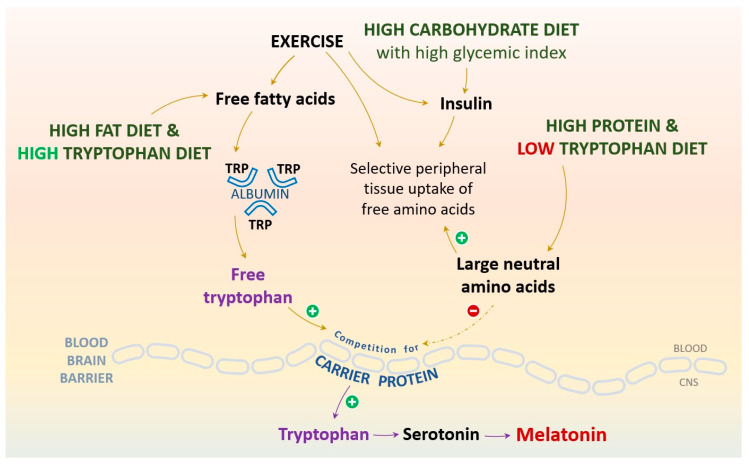Figure 1.
The increase in melatonin production can be achieved through various nutritional interventions that aim to enhance tryptophan (Trp) availability at the CNS level. Generally, this process can be realized by either increasing free Trp availability or reducing the relative plasma concentration of large neutral amino acids (LNAA). The passage of tryptophan through the blood–brain barrier constitutes a multifaceted process, as the active transport of amino acids to the brain, performed by a particular carrier protein, is accessible to all LNAA and is not exclusive to tryptophan. So, tryptophan must engage in competition with other LNAA, which are often more abundantly available in the food supply, to secure transport into the brain. To augment the availability of tryptophan for serotonin and melatonin synthesis, it is advantageous to redirect these competing amino acids toward peripheral tissues. This diversion can be facilitated through the release of insulin, which in turn fosters protein synthesis in muscle tissue. Notably, the process of insulin shunting effectively diminishes the pool of LNAA that reach the brain, thereby liberating transporters for tryptophan binding. In light of this mechanism, the co-consumption of carbohydrates in conjunction with tryptophan-rich foods holds the potential to enhance the entry of tryptophan into the brain. These objectives can also be accomplished by adopting a high-protein diet richer in tryptophan compared to LNAA, consuming carbohydrates to elevate the free Trp-to-branched-chain amino acid (BCAA) ratio and stimulate insulin release, which facilitates BCAA uptake into muscle. Additionally, melatonin production can be influenced by the consumption of high-fat meals, leading to increased free fatty acids and subsequently higher free Trp levels. Furthermore, engaging in physical exercise can impact both free fatty acids and insulin levels, contributing to the intensification of melatonin synthesis.

